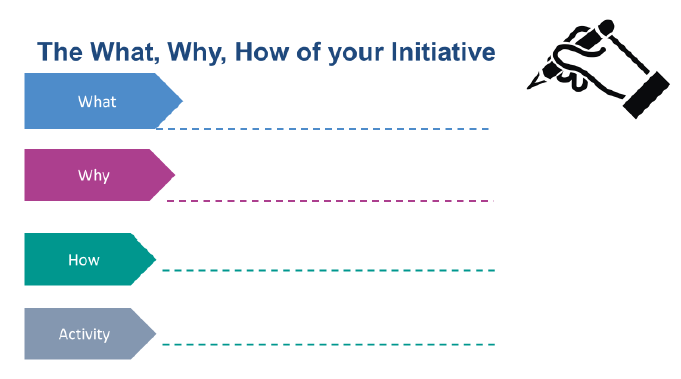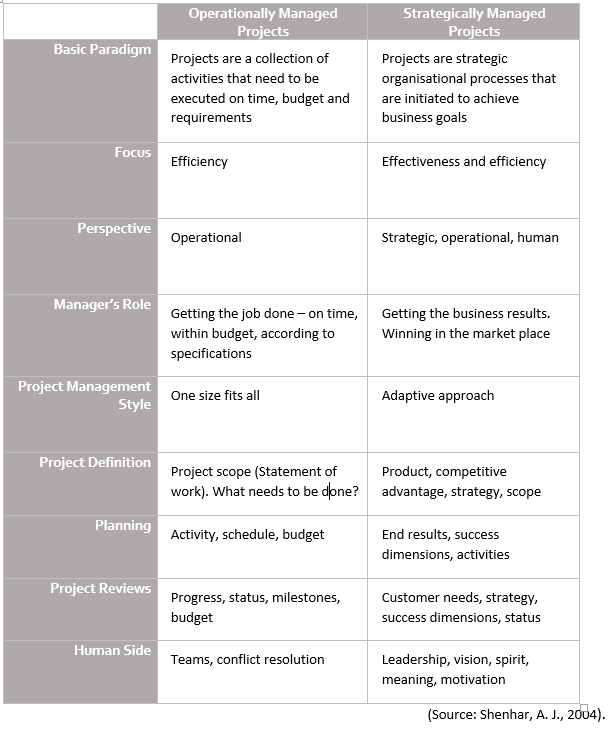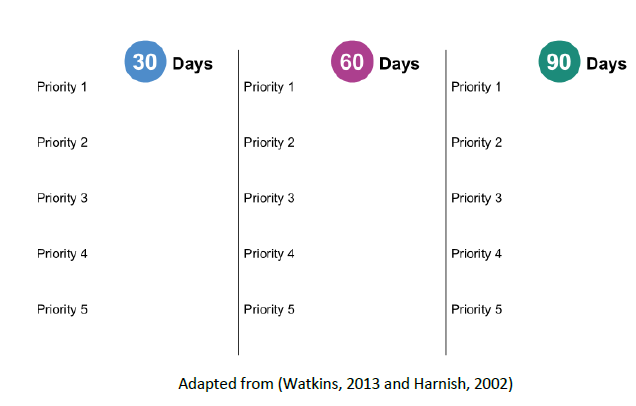Module 6: Measuring Performance Outcomes
Topic 6.4: Facilitating Project Management
Having considered complexity and context let’s now explore some tools and thinking about how to deliver outcomes within a complex environment. One approach is to consider project management as a delivery mechanism.
In this brief section, we can only provide you with some exploratory views of project management. Project management in itself is an entire discipline and well beyond the scope of this unit. In particular we focus on the concept of project management, as it relates to an organisation’s strategy, its people, and its overall approach to getting things done, in a complex environment.
Required
10 mins
More and more of the strategic activities of organisations and agencies occur in the context of projects and initiatives. Remington & Pollack (2008)[1] explore the roles and behaviour of project managers and executive sponsors in the context of projects in complex environments. A crucial observation from their research is encapsulated in this statement:
“It is clear from this research that the role capabilities of project managers who have successfully delivered complex projects differ substantially from capabilities centring on planning, monitoring and reporting” (Remington & Pollack, 2008, p.125)
- How does this relate to your experience of project management in your context?
A suggestion is that project managers and sponsors should focus on longer term or strategic goals of delivering the organisational benefits, with a focus on the tactical and strategic perspectives of project management (Cooke-Davies, 2004; Shenhar et al., 2005)[2]. Many of you will have seen examples of the tension between tactical and strategic project objectives in your organisations.
To explicate the nature of strategically managed projects, Shenhar’s (2004)[3] research encompassed 600 projects focussing on why certain well planned projects often conclude with disappointing results, while others, even when failing to meet schedule and budget goals, may later deliver outstanding results.
Shenhar (2004) offers what he suggests is a new approach to project management, which he entitles “Strategic Project Leadership (SPL)”. Shenhar (2004) offers a compelling argument for recognising the strategic nature of projects within an organisation and adopting a corresponding strategic approach to project management. In particular, note Shenhar’s (2004) comparison between strategically and operationally managed projects, reproduced below in Table 6.2. For operational managers, the key factor here is to understand the strategic relevance and nature of the project, and the benefits of having a ‘strategic mindset’.
Table 6.2: Comparing Strategically Managed and Operationally Managed Projects
Required
20 mins
- After reading the notes in Table 6.2 what do you notice?
- How were these applied to your recent experience with project management?
- What worked particularly well?
As a wrap on to this section, note the following quote from Remington & Pollack:
The point here is that regardless of the various projects and their context, the contribution to the overarching ‘public value’ should be clear to all, and continually communicated.
Rapid Success Tools
Here is a short ‘tutorial’ in achieving some ‘quick wins’ and sharing ways to focus on important outcomes.
Establishing the importance and value of any initiative is linked to calculating and communicating its value. The What Why How model (Sinek, 2011)[4] helps to give an initiative power and meaning. It is also easily communicated, shared and socialised.
Figure 6.5 The What, Why, How of Your Initiative

Required
10 minutes
For more details watch this summary of the TedTalk, Simon Sinek – Start With Why.
The Rockefeller 5+ 1’, developed from the Rockefeller strategy tool kit (Harnish, 2002)[5] is a ‘rapid’ decision tool and a useful approach to use to be able to establish the importance and relevance of an initiative within a portfolio of initiatives and opportunities. The basic premise of the tool that any leader, manager or project lead, can and should only have five core priorities, that link with the five core priorities of the division or organisation as a whole.
If this process is followed throughout the organisation, then the most senior leaders in the organisation would set the five core priorities, and then ensure that each and every team, and every team member, is working on their own core priorities, that can be explicitly linked to one or more of the organisation’s objectives! The idea then is that at any given time, all behaviours and actions are linked to, and measured by, their impact on those ‘top five’.
One additional piece, the ‘+1’, is the idea that in fact at any given moment, those delivering on outcomes, should be completely focused on the ‘#1 priority’ at that moment!
Another component of the ‘getting things done’ action set is the addition of the Watkin’s 30:60:90 principles (Watkins, 2013)[6], adapted here for this purpose. The basic principle of the tool is that the first 90 days of a project can be mapped out, as a planning horizon, on large, visible and prominent display.
Within the first 30 days, the project should be scoped, team members on boarded and actioned, measures specified and all structures and needed resources in place. By the next 30 days, at the 60-day mark, there should be significant progress made on the initiative, and a retrospective and reflection exercise undertaken, with adjustment steps as necessary.
At the 90-day mark, the project should be measured against the key measures that were specified, and the team should have a strong and robust conversation about progress and outcomes. At this stage too, the project overall should be evaluated. Stop, Modify, or Proceed decisions, should be taken.
Each 30-day stage should be an open, shared and transparent gathering, and the 90 Day Mark should be an explicit event, with key stakeholders and seniors leaders present. A ’90 Day Breakfast’ event is a great way to do this.
At times, team leaders will try to reject such short, clear and visible milestones, with the comment that their project is much longer term, more complex, or involves far too many stakeholders to be useful. The simple fact is that a year comprises four times 90-day periods; two years is eight times 90-day periods, etc. Any project no matter how complex has key high-level priorities and time lines, and core essential stakeholders.
By combining the ‘5+1’ and’30:60:90’, many of those objections can be overcome, and success can be explicit and celebrated. By adding the ‘5+1’, the teams can stay focused on those top ‘5’ and be explicitly working on the ‘#1’.
The following figure shows a possible approach to this combined tool.
Figure 6.6:
Where possible, these and any other processes should be shared and visible. Here is an example of a strategy workshop!
It is essential for you to be sure that these tools do not replace any of the AGILE, Design Thinking, or formal project management tools you may be currently using. They are a visible, usable and easily-shared approach to sharing, pacing and hopefully celebrating progress and successes!
- Remington, K. and Pollack, J. (2008) Tools for Complex Projects Routledge ↵
- Cooke-Davies, T. J. (2004). Project Success. In P. W. G. Morris & J. K. Pinto (Eds.), The Wiley Guide to Managing Projects (pp. 99-122). ↵
- Shenhar, A. J. (2004). Strategic Project Leadership®--Toward a strategic approach to project management. Research and Development Management, 34(5), 569-578. ↵
- Sinek, S. (2011), Start with Why: How Great Leaders Inspire Everyone to Take Action. YouTube ↵
- Harnish, V. (2002) Mastering the Rockefeller Habits: What you must do to increase the value of your growing firm. Gazelles Inc. ↵
- Watkins, D (2013) The First 90 Days: Proven Strategies for Getting Up to Speed Faster and Smarter. Harvard Business Review Press; Updated, Expanded edition (May 14, 2013) ↵




